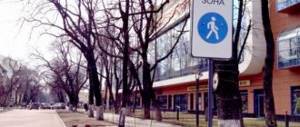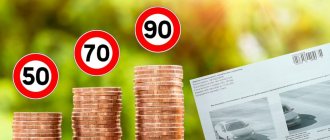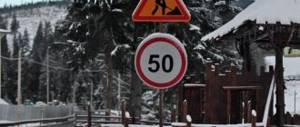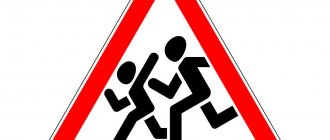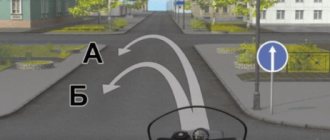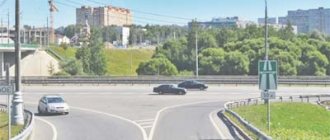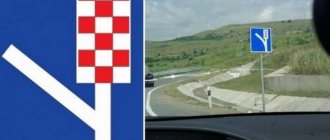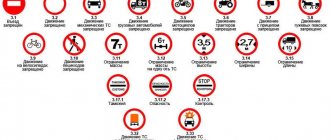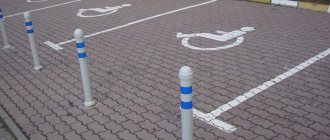- 1. What is the coverage area of the speed limit sign? 1.1. Effect of the “Maximum Speed Limit” sign with a coverage area sign
- 1.2. Effect of speed limit until end of limit zone signs
- 1.3. Effect of the “Speed Limit” sign to a new similar sign
- 1.4. Effect of the “Speed Limit” sign before an intersection or populated area
The validity zones of signs in the traffic rules for 2021 are regulated either by the Appendix to the traffic rules of the same name - road signs and markings, or by GOST R 52289-2004. In our case, the effect of a speed limit sign can be determined by the presence of an intersection, a sign indicating the length of the limit, as well as signs that remove such a limit, or the beginning or end of a populated area. But let's talk about everything in order!
What is the coverage area of a speed limit sign?
Sign 3.24 “Speed limit”
The “Speed Limit” sign is installed on dangerous sections of roads near sharp turns or concentrations of accidents, where it is dangerous to move at the initially permitted speed. In addition, sometimes a sign is installed where it is allowed to drive at a higher speed than required by the conditions of the city, highway or highway. For example, if in a city there is a speed limit sign of 80 km/h, then you can drive exactly up to 80 kilometers per hour, and not up to 60, as required by traffic rules in the city.
Also, according to GOST for 2021? You cannot limit the speed with such signs to more than 20 km/h. That is, if you are driving along a highway where the speed limit is 90 km/h, and along the way you come across a “Speed Limit” sign with the number 60, then such a sign is installed illegally - if you want to limit the speed to 60 kilometers per hour, then first there must be speed limit sign up to 70 or 80, and only then, after 100-150 meters sign 60 (clause 5.4.22 of GOST).
Just like any other prohibitory signs, the speed limit sign is not endless, even if there is no corresponding sign for the end of the limit. The priority of the conditions of the sign here is similar to the “No Stopping” sign, and let's look at all the conditions for limiting the areas of action.
Effect of the “Maximum Speed Limit” sign with a coverage area sign
Everything is simple here: immediately under the sign 3.24 on the same column there is a sign 8.2.1 (see figure below), the number on which indicates the coverage area from the sign until the restriction is lifted. If, for example, the sign says 40, and the sign says 150 m, then this means that for the next 150 meters we must drive at a speed of no more than 40 kilometers per hour.
By the way, it is 40, not 60 or 59 km/h, that is a violation, and there is a punishment for this violation. It is prohibited to drive at a speed above 40 - this is a violation, there is simply no punishment provided if the speed exceeded is less than 20 km/h. But in the event of an accident, for example, such an excess may not be taken into account in your favor.
Effect of speed limit until end of limit zone signs
If a sign is used without a sign with a speed limit zone, then after such a sign there may be a “End of speed limit zone” sign with a crossed out speed value on a white background (and not on white with a red frame, like a prohibitory sign). Then the prohibition of the speed limit sign no longer applies after the end of the limit, and we can drive at the maximum speed allowed for this section of the road (city or other populated area - 60 km/h, highway - 90 km/h, highway - 110 km/h) . The same maximum speed ban is lifted by the sign “End all restrictions” - an empty sign with diagonal strikeouts on a white background.
In addition, signs at the end of the coverage area of prohibiting traffic rules signs may be placed, including if the prohibition sign itself was standing with a coverage area sign. And this is logical, isn’t it, because we shouldn’t measure the distance indicated on the sign with a tape measure?!
Effect of the “Speed Limit” sign to a new similar sign
If after sign 3.24 a new sign with a different restriction value is installed, then the previous restriction does not apply, which is quite logical. Less logical is the situation when a new constraint sign sets a greater value for such a constraint. For example, there was a sign “60” and after it there was a sign “80”. Then a new restriction also applies, and the previous one is removed.
Effect of the “Speed Limit” sign before an intersection or populated area
If there are no signs under the speed limit sign and if there are no signs for the end of the speed limit or the removal of all restrictions of prohibition signs, then the speed limit prescribed by sign 3.24 is valid either until the nearest intersection or until the “Built-up area” or “End of built-up area” sign. What you see first along the way will cancel the effect of this prohibitory sign. Moreover, a roundabout intersection is also a full-fledged intersection.
At the same time, remember that not all intersections mean the end of the coverage area of the “Speed Limit” sign. Various kinds of secondary exits or junctions of dirt roads into forests, exits into fields and other minor roads not marked with a road junction warning sign (warning signs are installed 50-100 meters away in populated areas and 150-300 meters away on highways), then is one of these signs:
Remember also that exits from adjacent territories are not intersections according to the interpretation of traffic rules and therefore do not cancel the effect of the “Speed Limit” sign.
As for the end or, accordingly, the beginning of a populated area, this is not just a visible beginning or end, respectively, but their designation by one of the following information signs:
| The beginning of the settlement | End of a settlement |
Also keep in mind that the Residential Zone sign overrides the restriction. In general, a residential area rarely just begins with a road, but, most likely, you drive off the road to another, and the new one has its own rules. But even if you find yourself in a rare exception, when a restricted road moves into a residential area, then remember that the 2021 traffic regulations require a maximum speed of 20 kilometers per hour in a residential area.
Fines for exceeding the speed limit
If a driver violates the established rules in a zone with a maximum speed limit, an administrative penalty will be applied to him. The fine for speeding depends on how fast the car was going and how many km/h it exceeded the posted maximum speed.
The procedure for penalties for violating the speed limit is as follows:
- If the permitted speed was exceeded by 10–20 km/h, the driver can be stopped by a traffic police officer. However, the driver will only get off with a warning.
- If the driver moved 20–40 km/h faster than the permissible limit, he may be fined 500 rubles. This norm is prescribed in Art. 12.9, part 2 of the Administrative Code.
- If the excess is from 40 to 60 km/h, the penalty will be from 1000 to 1500 rubles. In case of repeated violation, the amount of the fine increases and amounts to 2000–2500 rubles.
- If the driver exceeded the speed limit by more than 60 km/h, the punishment is a fine of 2000–2500 or deprivation of rights for 4–6 months. For a repeated violation, you can lose your driver's license for a year.
- If you exceed the speed limit by 80 km/h or more, the fine is 5,000 rubles with deprivation of rights for six months. Repeated violation - imprisonment for a year.
Attention! If the sign was installed in violation of the current Traffic Rules or legislation, the fine can be challenged.
What is the coverage area of the temporary speed limit sign?
Temporary speed limit signs are usually placed during road repairs or construction of structures near this road and in other cases of temporary concentration of a dense flow of cars on a section of the road. A temporary prohibition sign, unlike a permanent one, is made on a yellow background instead of white.
Temporary sign 3.24 “Speed limit”
The end of the coverage area of a temporary “Speed Limit” sign, according to the Road Traffic Rules, is no different from similar areas of coverage of a permanent restriction - it can be canceled by the nearest intersection, the end/beginning of a populated area, the sign of the end of the speed limit or all restrictions, or the spreading distance, if installed with with the appropriate sign.
In practice, for 2021, most often there are temporary signs o, because a significant reduction in speed with temporary signs is required, which means that several such signs have been installed, gradually limiting the speed lower and lower.
Also keep in mind that automatic photo and video recording of speeding is not allowed in areas where temporary signs are installed. Simply put, speed violators cannot be caught on auto-fixation cameras if such speed is limited by a temporary sign. But an inspector with a camera in his hand, which simply records the speed of the car for subsequent proof of excess, can issue a fine if there was such a punishable excess.
General rules
Graphic object 3.24 refers to prohibition signs.
It is a white circle with a red outline, inside which there are black numbers indicating the maximum permitted speed. Compliance with the requirements of this sign is mandatory for all types of vehicles. Sanctions for non-compliance with the speed limit are provided for in Article 12.9 of the Code of Administrative Offenses of the Russian Federation. The type of penalty and its size will depend on how many kilometers per hour the current limit was exceeded. The punishment can be either a fine or deprivation of the right to drive a vehicle.
The area of effect of symbol 3.24 begins immediately behind the place where it is installed. This means that you need to reduce speed in advance, and not at the moment when the car reaches the sign. According to GOST R 52289-2004, the distance at which an object must be visually distinguishable cannot be less than 100 m. Therefore, the driver always has a few seconds left to slow down to the required numbers.
The “Maximum Speed Limit” sign remains in effect until the nearest intersection. This rule applies equally to city streets and country highways. If there is not a single intersection within the boundaries of a populated area, then symbol 3.24 continues to be in effect until you leave it. In this case, the driver can begin to accelerate immediately after passing sign 5.24.1.
It is important to keep in mind that the “Maximum Speed Limit” road symbol does not cease at exit points from areas adjacent to the roadway. This includes courtyards, gas stations, shops, businesses, etc. Sign 3.24 also remains in effect after unpaved roads that are not marked with special graphic objects (2.3.1-2.3.7) join the highway.
It happens that symbol 3.24 is installed at the entrance to a populated area. Then its effect extends to sign 5.23.1 or 5.23.2. Once a motorist enters a city or town, he must obey the general speed limit (60 km/h).
What does not cancel the coverage area of the “Speed Limit” sign?
So, above we looked at which road signs and intersections cancel the distribution of sign 3.24. Now, so that you are not mistaken, we will present what does not cancel the speed limit:
- pedestrian crossings;
- tunnels, bridges, overpasses;
- if the road turns without forming intersections (even though it turns in the opposite direction);
- the “Main Road” sign, if it is not installed in front of the intersection (according to GOST, this sign can be installed simply on a section of the road, prohibiting stopping according to traffic regulations);
- traffic lights, if they are installed not at an intersection, but, for example, to allow pedestrians to pass.
If the coverage area of the speed limit sign on the plate is greater than the distance to the intersection
If it suddenly turns out that the sign under the “Speed Limit” sign says “2 km”, but after one kilometer you find an intersection or the end/beginning of a populated area, then know that the latter cancel the effect of the sign prohibiting moving at a speed higher than the specified one on the sign. That is, an intersection or the beginning/end of a populated area in this case takes precedence over a sign. This is all because in this case, such an organization of the signs is contrary to GOST and means that the road workers placed the sign incorrectly. And GOST clearly states that the range of action on the sign cannot be greater than the distance to the intersection or the nearest populated area or its end.
What signs cancel the speed limit?
The sign can also be in areas where there are no intersections or populated areas. How to comply with the speed limit in such conditions? This is how “newbies” most often get confused.
The length of the distance where the sign is valid is indicated by a special sign. If there is a limit, but there is no sign, then it will continue to apply until the “End of speed limit zone” sign. It looks the same as the sign discussed in this article, but with a line through it.
Sometimes the specified designation becomes invalid - after “End of all restrictions”. It is easy to recognize - the white background is crossed out with a line diagonally. Although it implies the abolition of all signs, this is not so.
It only cancels:
- minimum distance length;
- prohibition of overtaking;
- sound signal;
- as well as parking and stops in various places;
- and speed limit.
It may be located along with a sign indicating the distance. This means that the effect of the sign in this place is terminated.
